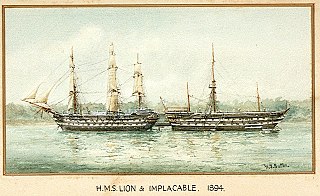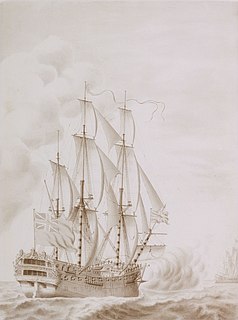
HMS Cornwall was an 80-gun, third rate, ship of the line built for the Royal Navy in the 1690s. She served in the War of the Grand Alliance, and in her first year took part in the Battle of Barfleur and the action at La Hougue.

HMS Cornwall was a 74-gun third-rate Vengeur-class ship of the line built for the Royal Navy in the 1810s. She spent most of her service in reserve and was converted into a reformatory and a school ship in her later years. The ship was broken up in 1875.
Bristol was a British 44-gun fourth-rate frigate, originally built for the navy of the Commonwealth of England during the 1650s. She was taken over by the Royal Navy after the Restoration of the monarchy in 1660, and was thereafter styled HMS Bristol. The ship participated in multiple battles during the Anglo-Spanish War of 1654–60, and the Second and Third Anglo-Dutch Wars.

HMS Bristol was a 50-gun Portland-class fourth-rate ship of the line, built for the Royal Navy in the 1770s. She served as a flagship during the Battle of Sullivan's Island, Charleston, South Carolina in 1776 during the American Revolutionary War and later participated in the 1783 Battle of Cuddalore during the Anglo-French War of 1778–83. By 1787 the ship had been converted into a church ship. Converted into a prison ship in 1794, Bristol instead served as a hospital ship until she was broken up in 1810.

HMS Gloucester was a 74-gun, third rate Vengeur-class ship of the line built for the Royal Navy in the 1810s. She played a minor role in the Napoleonic Wars and was cut down into a 50-gun fourth rate frigate in 1831–32. The ship was converted into a receiving ship and broken up in 1884.

HMS Superb was a 80-gun second rate Vanguard-class ship of the line built for the Royal Navy in the 1840s. She was broken up in 1869.
HMS Centurion was a 80-gun second rate Vanguard-class ship of the line built for the Royal Navy in the 1840s.

HMS Lion was a 80-gun second rate Vanguard-class ship of the line built for the Royal Navy in the 1840s. She was fitted with steam propulsion in 1858–1859. In 1871 Lion was converted into a training ship at HM Dockyard, Devonport. The ship was sold for scrap in 1905.

HMS Colossus was a 80-gun second rate Vanguard-class ship of the line built for the Royal Navy in the 1840s. The ship was fitted with steam propulsion in 1854–1855, and was sold for scrap in 1867.
HMS Gloucester was a 60-gun fourth rate ship of the line built for the Royal Navy during the 1690s. She spent most of her career in the West Indies and participated in the 1701–15 War of the Spanish Succession. The ship was hulked in 1708 and broken up in 1731.
HMS Falmouth was a 50-gun fourth rate ship of the line built for Royal Navy in the 1690s. The ship participated in several battles during the Nine Years' War of 1688–97 and the War of the Spanish Succession (1701–1715), including the action of August 1702. She was captured by the French in 1704.

HMS Burford was a 70-gun third rate ship of the line of the Royal Navy, built at Deptford Dockyard to the 1719 Establishment, and launched on 19 July 1722. Burford was notably the early posting of both John Forbes and John Byng, both of whom rose to become Admirals.
HMS Falmouth was a 50-gun fourth-rate ship of the line built for the Royal Navy in the first decade of the 18th century. The ship participated in several battles during the War of the Spanish Succession (1701–15) and the War of Jenkins' Ear (1739–48).

HMS Gloucester was a 50-gun fourth-rate ship of the line built for the Royal Navy in the 1710s. She participated in the 1701–15 War of the Spanish Succession. The ship was burned to prevent capture after she was damaged in a storm during Commodore George Anson's voyage around the world in 1742.
The 1719 Establishment was a set of mandatory requirements governing the construction of all Royal Navy warships capable of carrying more than 20 naval long guns. It was designed to bring economies of scale through uniform vessel design, and ensure a degree of certainty about vessel capability once at sea, and was applied to all vessels from the first-rate to the fifth-rate. Once in effect, it superseded the 1706 Establishment, which had specified major dimensions for ships of the second-rate, third-rate and fourth-rate only.

HMS Weymouth was a 60-gun fourth rate ship of the line of the Royal Navy, launched in 1736 and in service during the War of the Austrian Succession. Initially stationed in the Mediterranean, she was assigned to the Navy's Caribbean fleet in 1740 and participated in Battle of Cartagena de Indias in 1741. Decommissioned later that year, she was restored to active service in the Caribbean in 1744. A navigational error on 16 February 1745 brought her too close to the shore of Antigua, where she was wrecked upon a submerged reef. Three of Weymouth's officers were subsequently found guilty of negligence, with two required to pay substantial fines and the third sentenced to a two-year jail term.

HMS Eagle was a 58-gun fourth rate ship of the line of the Royal Navy.

HMS Gloucester was a 50-gun fourth rate ship of the line built for the Royal Navy in the 1740s. She participated in the 1740–48 War of the Austrian Succession, capturing four French privateers. The ship was broken up in 1764.
HMS Falmouth was a 50-gun fourth rate ship of the line built for the Royal Navy during the 1750s. She participated in the Seven Years' War and was badly damaged during the Battle of Manila in 1762 and was abandoned as unseaworthy in the East Indies in 1765.

HMS Thetis was a 46-gun Leda-class fifth-rate frigate built for the Royal Navy during the 1810s. She was first commissioned in 1823 and was assigned to the South America Station three years later. The ship was wrecked in 1830 off Cape Frio, Brazil, with the loss of 22 crewmen; most of her cargo of bullion was successfully salvaged.













